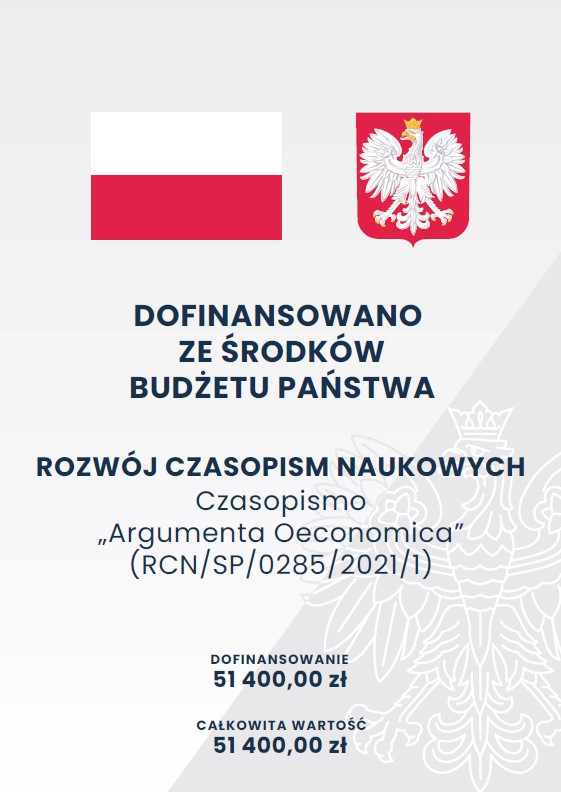The impact of the credit rating of the ESG debt instruments’ issuer on the coupon rate
Keywords:
sustainable finance, credit rating, ESG investingAbstract
This article investigates the potential impact of having credit ratings assigned by multiple rating agencies, including S&P, Moody’s, and Fitch, on the issuance of environmental, social and governance (ESG) bonds. It examines the impact on both the coupon rate offered and the volume of debt instruments issued. The research employed a mixed research methods approach, utilising observation methods and analysis of source data. Data for this research was obtained from the Refinitiv Eikon information database. The credit ratings of issuers as at the date of issuance of ESG instruments were analysed, focusing on the credit ratings assigned to issuers of ESG debt instruments issued between 2012 and 2021. Only instruments that were in circulation as of 31 December 2021 were included in the study. The findings suggest a potential link between the number of credit ratings an issuer possesses and both the offered coupon rate and the volume of ESG instruments issued. A review of the existing literature, both theoretical and empirical, does not provide clear evidence of how an issuer’s credit rating affects the success of debt issuance in relation to meeting ESG criteria.
Downloads
References
Agliardi E., & Agliardi R. (2021). Pricing climate-related risks in the bond market. Journal of Financial Stability, 100868. https://doi.org/10.1016/j.jfs.2021.100868
Ammer, J., & Packer, F. (2000). How consistent are credit ratings? A geographic and sectoral analysis of default risk. International Finance Discussion Papers, 668.
Apergis, N., Poufinas, T., & Antonopoulos, A. (2022). ESG scores and cost of debt. Energy Economics, 112, 106186. https://doi.org/10.1016/j.eneco.2022.106186
Asimakopoulos, P., & Asimakopoulos. S. (2019). A tale of two tails: Cross credit ratings and cash holdings, Working Paper, 2-4.
Aslan, A., Poppe, L., & Posch, P. (2021). Are sustainable companies more likely to default? Evidence from the dynamics between credit and ESG ratings. Sustainability, 13(15), 8568. https://doi.org/10.3390/su13158568
Avetisyan, E., & Hockerts K. (2017). Consolidation of the ESG rating industry as enactment of institutional retrogression. Business Strategy and the Environment, 26 (3), 316-330.
Bongaerts, D., Cremers, K. J. M., & Goetzmann, W. N. (2012). Tiebreaker: certification and multiple credit ratings. The Journal of Finance, 67 (1), 113-152. https://doi.org/10.1111/j.1540-6261.2011.01709.x
Botosan, C. A. (1997). Disclosure level and the cost of equity capital. The Accounting Review, 72(3), 323-349. https://ssrn.com/abstract=2926
Crifo, P., Diaye, M. A., & Oueghlissi, R. (2017). The effect of countries’ ESG ratings on their sovereign borrowing costs. The Quarterly Review of Economics and Finance, 66, 13-20. https://doi.org/10.1016/j.qref.2017.04.011
Duliniec, A. (2015). Inwestowanie społecznie odpowiedzialne – przejściowa moda czy trwała tendencja? Zeszyty Naukowe Uniwersytetu Ekonomicznego w Krakowie 937(1), 39-49. https://doi.org/10.15678/ZNUEK.2015.0937.0103
Eliwa, Y, Aboud, A., & Saleh, A. (2021). ESG practices and the cost of debt: Evidence from EU countries. Critical Perspectives on Accounting, 79, 102097. https://doi.org/10.1016/j.cpa.2019.102097
Flammer, C. (2021). Corporate green bonds. Journal of Financial Economics, 142(2), 499-516. https://doi.org/10.1016/j.jfineco.2021.01.010
Goodhart, Ch. (2010). How, If At All, should Credit Ratings Agencies (CRAs) be Regulated? In Griffith-Jones, S., Ocampo, J. A., & Stiglitz, J. E. (Eds.). Time for a visible hand: lessons from the 2008 world financial crisis. Oxford University Press, 164.
Jewell, J., & Livingston, M. (2000). The impact of a third credit rating on the pricing of bonds. Journal of Fixed Income, 10(3).
Kiesel, F., & Lücke, F. (2019). ESG in credit ratings and the impact on financial markets. Financial Markets, Institutions & Instruments, 28, 263-290. https://doi.org/10.1111/fmii.12114
Kisgen, D. J. (2006). Credit ratings and capital structure. The Journal of Finance, 61(3), 1035-1072. https://doi.org/10.1111/j.1540-6261.2006.00866.x
Kisgen, D. J. (2009). Do firms target credit ratings or leverage levels? Journal of Financial and Quantitative Analysis, 44 (6), 1323-1344. https://doi.org/10.1017/S002210900999041X
Larcker, D. F, & Watts, E. M. (2019). Where’s the greenium? Rock Center for Corporate Governance at Stanford University Working Paper, No. 239. Stanford University Graduate School of Business Research Paper No. 19-14. https://doi.org/10.2139/ssrn.3333847
Livingston, M., Wei, D., & Zhou, L. (2010). Moody’s and S&P ratings: Are they equivalent? Conservative ratings and split rated bond yields. Journal of Money, Credit and Banking, 42 (7), 1267-1293.
Pineau, E., Le, P., & Estran, R. (2022). Importance of ESG factors in sovereign credit ratings. Finance Research. Letters, 49 (C), 102966. https://doi.org/10.1016/j.frl.2022.102966
Riaz, Y., Shehzad, C. T., & Umar, Z. (2019). Pro-cyclical effect of sovereign rating changes on stock returns: A fact or factoid? Applied Economics, 51 (15), 1-14. https://doi.org/10.1080/00036846.2018.1527465
Ruoke, Y. (2020). Credit ratings in the age of environmental, social, and governance (ESG). Corporate Social Responsibility (CSR) eJournal. https://doi.org/10.2139/ssrn.3595376
Sharfman, M. P, & Fernando, C. S. (2008). Environmental risk management and the cost of capital. Strategic Management Journal, 29, 569-592. https://doi.org/10.1002/smj.678
Scott-Quinn, B., Cano, D., Watson, R., Fergusson, R., Pacheco C., & Kelly K. (2015). Guide to infrastructure financing: bank loans, debt private placements and public bonds-smoothing the pathway for effective funding. AFME-ICMA, 5-52.
Zanin, L. (2022). Estimating the effects of ESG scores on corporate credit ratings using multivariate ordinal logit regression. Empirical Economics, 62, 3087-3118. https://doi.org/10.1007/s00181-021-02121-4
Downloads
Published
License
Copyright (c) 2024 Sylwia Frydrych

This work is licensed under a Creative Commons Attribution-ShareAlike 4.0 International License.








